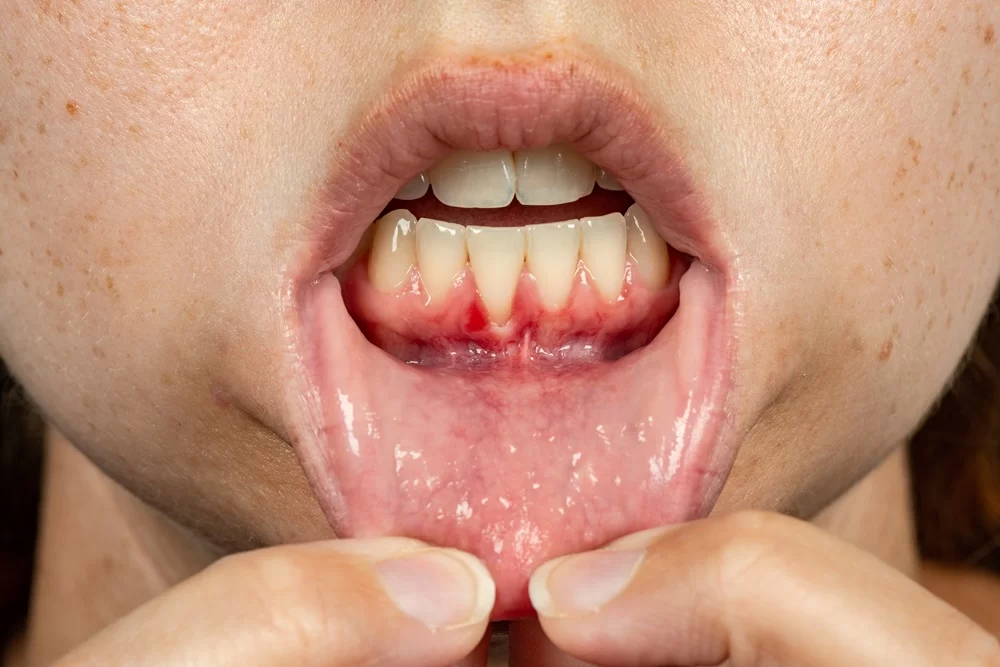
Symptoms of a Gum Infection and Treatment: How to Identify and Treat Gum Infections
- What is a Gum Infection?
- Symptoms of a Gum Infection
- Causes of Gum Infections
- Treatment Options for Gum Infection
- Preventing Gum Infections
What is a Gum Infection?
A gum infection, also known as gingivitis or periodontal disease, is a common condition that occurs when bacteria infect the gum tissue. The infection can start as mild inflammation (gingivitis) but can progress to more severe forms of gum disease, leading to tissue damage and tooth loss if left untreated. The infection often results from poor oral hygiene that encourages plaque buildup, which leads to the inflammation of the gums.
Symptoms of a Gum Infection
The symptoms of a gum infection can range from mild to severe, depending on the stage of the infection. Early identification and treatment are crucial in preventing the condition from worsening. Some common symptoms of a gum infection include:
1. Swollen or Puffy Gums
One of the first signs of a gum infection is swollen or puffy gums. This can happen due to inflammation caused by bacteria that irritate the tissue.
2. Red or Bleeding Gums
Gums that bleed easily when brushing or flossing are another common symptom. This bleeding occurs because the gums are inflamed and irritated by the buildup of plaque and bacteria.
3. Persistent Bad Breath
Foul-smelling breath, known as halitosis, can result from the infection. The bacteria in the gums release compounds that cause unpleasant odors.
4. Receding Gums
As the infection progresses, the gums may begin to recede or pull away from the teeth. This exposes more of the tooth's root, which can lead to tooth sensitivity and an increased risk of tooth decay.
5. Painful Chewing
If the gum infection spreads deeper into the tissue, you may experience pain while chewing. The infected area becomes tender, and it may be difficult to chew without discomfort.
6. Abscesses or Pus Around the Teeth
In advanced stages of gum infection, pus may develop around the teeth or gums. This is a sign of an abscess, which indicates a more serious infection that requires immediate attention.
Causes of Gum Infections
Gum infections are primarily caused by bacteria that build up on the teeth and gums. However, several factors can increase the risk of developing an infection:
1. Poor Oral Hygiene
Inadequate brushing and flossing allow plaque to form on the teeth, leading to gum inflammation. If plaque is not removed, it hardens into tartar, which can only be removed by a dentist.
2. Smoking or Chewing Tobacco
Tobacco use can impair blood flow to the gums, making it harder for them to heal and fight infection. Smoking also reduces the effectiveness of the immune system in combating bacteria in the mouth.
3. Poor Diet
A diet high in sugary or acidic foods can contribute to plaque buildup, increasing the likelihood of gum infection. A lack of vitamin C can also weaken the gums and make them more prone to infection.
4. Hormonal Changes
Hormonal changes during pregnancy, menstruation, or menopause can make the gums more sensitive to infection, leading to an increased risk of gum disease.
5. Health Conditions
Conditions such as diabetes, certain medications, and illnesses that affect the immune system can make individuals more susceptible to gum infections.
Treatment Options for Gum Infection
If you suspect you have a gum infection, it’s important to seek dental care as soon as possible. Early treatment can help prevent the infection from spreading or causing long-term damage. Some common treatments for gum infections include:
1. Professional Dental Cleaning
A thorough cleaning by a dentist or dental hygienist is the first step in treating a gum infection. This involves removing plaque and tartar buildup from the teeth and gums to reduce the source of infection.
2. Scaling and Root Planing
In cases of more advanced gum infection, scaling and root planing may be necessary. This deep cleaning procedure involves scraping away tartar from beneath the gum line and smoothing the tooth roots to help the gums reattach to the teeth.
3. Antibiotics
In some cases, antibiotics may be prescribed to help clear up the infection. These can be in the form of oral medication or topical gels that are applied directly to the gums.
4. Surgical Treatment
If the infection has progressed significantly, surgical procedures may be necessary to remove infected tissue or to repair damaged gums. Gum grafts or flap surgery may be required to restore gum health and function.
Preventing Gum Infections
Prevention is always the best approach when it comes to gum health. Here are some tips to help you avoid gum infections:
1. Brush and Floss Regularly
Brush your teeth at least twice a day and floss daily to remove plaque and food particles from between your teeth and gums.
2. Visit Your Dentist Regularly
Regular dental check-ups and cleanings can help catch any potential gum issues before they become serious problems. Professional cleaning removes tartar that you cannot remove with a toothbrush.
3. Eat a Healthy Diet
A balanced diet rich in fruits, vegetables, and vitamins can help maintain healthy gums and prevent infection. Avoid excessive sugar, as it promotes plaque buildup.
4. Quit Smoking
If you smoke, quitting can improve your gum health and reduce your risk of gum disease.
If you're experiencing symptoms of a gum infection, don't wait for the condition to worsen. Seek treatment as soon as possible to avoid complications. Dentistry Toothtruth is here to provide expert care and treatment options for gum infections. Click here to learn more and schedule your consultation today!







 Seung H. Baek, DDS, Inc.4.0 (19 review)
Seung H. Baek, DDS, Inc.4.0 (19 review) Graylyn Dental4.0 (681 review)
Graylyn Dental4.0 (681 review) David M. Wolf DDS, PC5.0 (298 review)
David M. Wolf DDS, PC5.0 (298 review) Village Dental Center5.0 (393 review)
Village Dental Center5.0 (393 review) Tranquil Dental4.0 (372 review)
Tranquil Dental4.0 (372 review) Duxbury Dental4.0 (71 review)
Duxbury Dental4.0 (71 review) The Importance of Oral Health Education During Pregnancy for a Healthy Pregnancy
The Importance of Oral Health Education During Pregnancy for a Healthy Pregnancy Best Tips for Brushing Your Teeth Properly for Healthy Gums: Essential Techniques for Oral Health
Best Tips for Brushing Your Teeth Properly for Healthy Gums: Essential Techniques for Oral Health Why Skipping Dental Checkups Can Lead to Bigger Oral Health Problems
Why Skipping Dental Checkups Can Lead to Bigger Oral Health Problems Advantages of Porcelain Dental Restorations
Advantages of Porcelain Dental Restorations How Can Diabetes Cause Tooth and Gum Problems? Preventing and Managing Oral Health Issues
How Can Diabetes Cause Tooth and Gum Problems? Preventing and Managing Oral Health Issues Healthy Habits for Promoting Good Oral Health and Hygiene: Tips for a Healthy Smile
Healthy Habits for Promoting Good Oral Health and Hygiene: Tips for a Healthy Smile